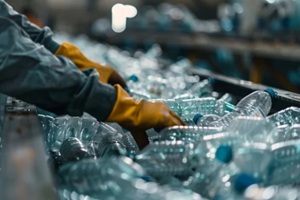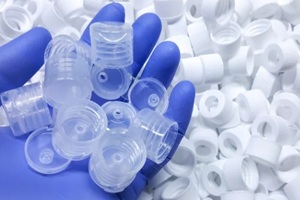February 10, 2025

Sustainable plastics are transforming the healthcare industry by addressing environmental concerns and the need for safety and efficiency in medical care. With growing awareness of the environmental impact of single-use plastics, healthcare providers and manufacturers are turning to innovative solutions in plastic sustainability that reduce waste, lower carbon emissions, and promote a circular economy.
Sustainable medical plastics are serving an important role in reducing the environmental impact of the healthcare industry. While single-use plastics are indispensable for assuring patient safety and preventing infections, they also generate a significant amount of waste. The need for sterility often justifies the use of disposable plastics, but their disposal also contributes to environmental degradation.
Incorporating sustainable practices in the production and management of medical plastics doesn’t just address potential environmental concerns, it also fulfills healthcare’s ethical responsibility to protect human health both locally and at a global level.
Healthcare facilities generate significant amounts of waste, with plastics making up a notable portion of it. Medical plastics, including packaging, devices, and disposable supplies, often end up in landfills or are incinerated, leading to greenhouse gas emissions.
This waste management approach exacerbates environmental issues, despite the fact that more than 85% of healthcare plastic waste is uncontaminated and capable of being recycled, according to information from the World Health Organization. Unfortunately, current recycling systems are underdeveloped, leaving the majority of this plastic waste to be disposed of in unsustainable ways, contributing to the healthcare sector’s growing environmental footprint.
The health of the environment is closely tied to human health, and the way medical plastics are managed plays a role in this connection. Poor waste management practices, including the incineration and landfilling of plastics, contribute to climate change, which in turn affects public health. Rising temperatures, air pollution, and contaminated water sources can lead to increased rates of disease, respiratory issues, and other health problems.
While plastics are essential for patient safety, healthcare’s reliance on them indirectly contributes to environmental harm, placing human health at further risk. To uphold their commitment to “do no harm,” healthcare providers must address these environmental challenges.

The healthcare industry faces numerous challenges in its efforts to make medical plastics more sustainable. Transitioning from traditional plastic use and disposal methods to more eco-friendly practices is complex, involving logistical, regulatory, and financial obstacles.
These obstacles impede the far-reaching adoption of sustainable solutions despite growing pressure to reduce the environmental footprint of healthcare.
One of the biggest challenges in managing medical plastics is the current reliance on incineration and landfill disposal. Sorting contaminated from non-contaminated plastics is a labor-intensive and costly process, which results in much of the plastic waste being incinerated or sent to landfills.
The infrastructure for recycling medical plastics is also currently limited, with few programs that can handle the volume and complexity of healthcare waste. These inefficiencies are compounded by regulatory restrictions that often treat all medical plastics as hazardous, even when they are not.
As a result, the environmental consequences are severe—incineration produces greenhouse gasses, and plastic waste in landfills takes centuries to degrade.
Medical plastics also face unique regulatory and financial barriers that complicate the transition to plastic sustainability.
Because medical plastics play a fundamental role in protecting public health, they are often exempt from regulations that target single-use plastics in other industries. As a result, new regulations are being introduced, such as Europe’s requirement for medical packaging to be recyclable by 2035. In the United States, oversight of plastic medical waste recycling is found in regulations with the Center for Disease Control (CDC), Occupational Safety and Health Administration (OSHA), and the U.S. Food and Drug Administration (FDA).
Financially, hospitals are under pressure, with limited budgets to allocate toward better plastic sustainability initiatives. Additionally, many hospitals lack the space and personnel needed to manage recyclable waste effectively, making it even more challenging to adopt sustainable practices at scale.
Join our PLASTICS Pulse newsletter today to receive updates on within the plastic industry while staying informed & connected.
The healthcare industry is making significant strides in addressing the environmental challenges posed by medical plastics through innovative solutions. New approaches in recycling, reprocessing, and advanced manufacturing are offering promising pathways toward greater plastic sustainability.
These developments are fueled by increasing collaboration within the industry and investment in cutting-edge technologies designed to promote circularity, lower carbon emissions, and create eco-friendly medical products.
Reprocessing and recycling initiatives are gaining traction as viable solutions for reducing medical plastic waste.
Organizations like the Healthcare Plastics Recycling Council (HPRC) are leading efforts to implement technologies such as molecular recycling, which breaks down plastics into their base molecules for reuse in manufacturing. This method allows plastics to be reprocessed without compromising quality, creating new products while reducing the need for virgin materials.
Pilot programs in hospitals, alongside collaborations between healthcare facilities and industry leaders, have shown that these initiatives can significantly divert medical plastic waste from landfills.
Advancements in manufacturing and sterilization technologies are also playing an important part in reducing the environmental footprint of medical plastics. Innovations such as low-energy sterilization methods and the use of bioplastics in packaging are helping healthcare facilities minimize their carbon emissions.
There is an increasing trend of integrating recyclable materials into the manufacturing of medical devices and packaging. These advanced technologies help maintain the high safety and sterility standards required in healthcare while also reducing energy consumption and emissions.

Staying informed about the latest developments in sustainable plastics is essential for healthcare professionals committed to reducing environmental impact. Ongoing advancements in recycling, manufacturing, and disposal solutions are transforming how the industry manages plastic waste today.
If you want to learn more about how sustainable plastics are revolutionizing the planet, visit PLASTICS, the Plastics Industry Association, to explore our wealth of resources. Also, consider becoming a member of the organization to stay updated on innovations and best practices in the global plastics industry.
PLASTICS and the Future Leaders in Plastics (FLiP) Committee are devoted to supporting and encouraging the next generation of plastics leaders who will play a crucial role in the innovation, technology and future of the plastics industry. FLiP’s mission is to provide young professionals under the age of 40 the exposure, education and resources they need to build lifelong careers in plastics. Want to join? Want to get your employees involved? Email: [email protected]